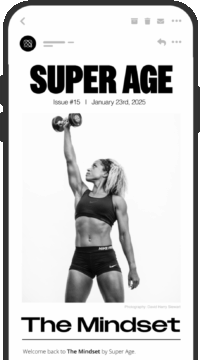4 Power Moves for Your Heart

Your heart isn’t just a pump. It’s a living, responsive organ that reflects how you move, eat, sleep, connect, and care for yourself.
Today, cardiovascular disease (CVD) accounts for more deaths than all forms of cancer and chronic respiratory disease combined. Nearly 1 in 2 U.S. adults have some form of CVD. But here’s the most important stat: it’s largely modifiable.
We used to think [hahrt helth]nounThe overall condition and function of the cardiovascular system, including blood pressure, cholesterol, and arterial health; critical for longevity and disease prevention.Learn More was just about diet and exercise but now we know it’s much more. Emerging research reveals that true cardiovascular care is not just what’s on your plate or how often you move, it’s how you manage stress, process trauma, feel supported, and stay meaningfully connected. The future of heart health lies in integrated, personalized care that combines exercise training, dietary support, cardiovascular risk management, and emotional well-being, guided by genetic insights, wearable technology, and human connection.
In other words, if you want to extend your [helth-span]nounThe number of years you live in good health, free from chronic illness or disability.Learn More, you can’t spot-treat your heart. You need an integrated, human approach.
4 Science-Backed Strategies that Strengthen Your Heart
These four science-backed strategies, smart training, intentional nutrition, meaningful touch, and mindful connection, go beyond the treadmill and into the core of what makes a heart strong and resilient in midlife and beyond..
1. HIIT That Works: The Right Kind of Intensity
High-Intensity Interval Training (HIIT) has been hyped as the fast track to cardiovascular fitness. But not all HIIT is created equal. The real gains come when you hit the right intensity, at the right duration, with full recovery between bouts.
When done correctly, HIIT can improve VO₂ max by 15–20%, boost muscle strength by 12%, reduce fall risk, and increase cognitive function by 10–15% (especially memory). That’s according to a 2025 meta-review of 18 studies on HIIT and continuous cardio in older adults. And it gets better: when paired with steady-state cardio, the combination supports both physical and mental [ri-zil-yuhns]nounThe ability to recover quickly from stress or setbacks.Learn More as we age.
How to Do HIIT Right:
Most people don’t push hard enough to get the benefits. To truly target longevity, your HIIT needs to be structured like this:
- Pick the right tool. Use a modality that lets you hit and sustain your max, like a rowing machine or air bike. Treadmills and outdoor runs make it harder to reach the right threshold.
- Go hard for 2–6 minutes. One- or two-minute intervals might work for beginners, but if you’re already active, longer work intervals better activate your VO₂ max.
- Work at your maximum. Each interval should feel like an all-out effort. If you’re rowing, test your 2,000m time, then use that pace as your interval target.
- Rest completely between intervals. Let your heart rate come down below 100 bpm before starting the next round. This could take several minutes.
- Stop when intensity drops. If your output slips, you’re no longer training at the right level. Wrap the session and build capacity over time.
How Often:
Start with 1 session per week, doing 2–3 intervals. Over time, work up to 5–7 intervals per session. That may take months, but the rewards are worth it. Pair this with 20–30 minutes of easy [zohn too kar-dee-oh]nounLow-intensity endurance training that builds metabolic health.Learn More six days a week, and you’ve got the gold standard for cardiovascular longevity.
2. The Portfolio Diet: Invest in [lon-jev-i-tee]nounLiving a long life; influenced by genetics, environment, and lifestyle.Learn More
Want to lower your LDL cholesterol by up to 30%? The Portfolio Diet might be your most elegant play. A 30-year Harvard study of over 210,000 people found that those who closely followed a “portfolio-style” plant-based diet had a 14% lower risk of [hahrt dih-zeez]nounConditions affecting heart health and circulation.Learn More. This approach combines multiple LDL-lowering foods for a compounding effect. “A lot of different foods can lower LDL cholesterol by 5–10%. The portfolio diet stacks those benefits,” says Harvard’s Andrea Glenn, co-author of the study.
The Big Five of the Portfolio Diet:
- Plant Protein: lentils, tofu, edamame, beans
- Nuts & Seeds: almonds, walnuts, flax, chia
- Viscous Fiber: oats, psyllium, eggplant, okra
- Plant Sterols: found in legumes, soy, hemp, nuts
- Healthy Fats: olive oil, avocado, peanut oil
Try building a “Super Portfolio Breakfast” with oatmeal, hemp milk, fruit, and chopped nuts for a cardioprotective start to the day.
3. The Science of Touch
Connection is cardio-protective. Touch is biologically powerful. Physical connection directly impacts cardiovascular health by activating the [par-uh-sim-puh-thet-ik nur-vuhs sis-tem]nounThe part of your nervous system that supports relaxation and digestion.Learn More, reducing [in-fluh-mey-shuhn]nounYour body’s response to an illness, injury or something that doesn’t belong in your body (like germs or toxic chemicals).Learn More, and enhancing heart rate variability (HRV), a key marker of resilience and heart function.
In some studies, people who received more frequent hugs from their partners had significantly higher levels of [ok-si-toh-sin]nounA hormone that promotes bonding, trust, and connection.Learn More and lower resting blood pressure and heart rate. Other studies found that touch decreases cortisol, our primary stress hormone. Another investigation found that gentle, affective touch improves HRV. Touch also supports emotional regulation and stress resilience. These shifts suggest that human contact plays a unique role in balancing nervous system and reducing cardiovascular risk.
Opportunities for touch can decline with age, due to isolation, bereavement, or cultural norms. It’s even more essential to recognize and restore physical connection as part of holistic heart health because sometimes, a simple human touch truly does go straight to the heart.
Why It Works:
- Reduces Stress: Touch triggers oxytocin release and lowers cortisol
- Lowers Blood Pressure: Affectionate contact helps regulate heart rate variability
- Boosts Emotional Resilience: Touch can reduce depression and anxiety, particularly in older adults
Simple Practices:
- Hug someone for 10–20 seconds (the sweet spot for nervous system benefit)
- Book a monthly massage
- Cuddle with a pet or offer a hand squeeze to someone who needs it
- Offer a caring hand to someone who may be touch-deprived
- Put your hand on your own heart and take a few deep breaths sending yourself some gratitude for taking a moment to care for yourself.
Micropractice: End your day with a moment of physical connection. Your heart will thank you.
4. A Meditation for Your Heart
Loving-Kindness meditation is a longevity practice. I’ve been practicing Loving-Kindness Meditation (LKM) for years. It’s not only shifted how I show up as a parent, partner, and editor, but it’s reshaped how I understand health. Studies show that LKM lowers heart rate, decreases inflammation, increases heart rate variability, and rewires the brain toward compassion and connection.
Neuroscientists have found that during loving-kindness meditation, theta brainwave activity increases while heart rate decreases, indicating a deeply restorative state. That’s not just inner peace, it’s heart protection.
Try This:
Find a quiet moment, sit in a supported way and connect with your body and your breath. Then, silently repeat phrases like:
“May I be safe. May I be healthy. May I live with ease.”
Breathe into the phrases and feel each one in your heart center. “These phrases are an act of generosity. They’re offering. They are gift-giving,” says Salzberg.
After a few minutes, extend those wishes to others, someone you love, someone you’re struggling with, and eventually, to all beings.
It’s called “the song of the heart” for a reason. Want more guidance? Try a Loving-Kindness audio meditation with Sharon.
Stronger Heart, Stronger Life
Your heartbeats sync with every moment of your life, without you even realizing it most of the time. Strengthening our hearts requires more than reps or recipes. It takes movement, nourishment, connection, and inner care. These four heart practices can help you build the foundation for a healthier more resilient life.
The information provided in this article is for educational and informational purposes only and is not intended as health, medical, or financial advice. Do not use this information to diagnose or treat any health condition. Always consult a qualified healthcare provider regarding any questions you may have about a medical condition or health objectives. Read our disclaimers.

